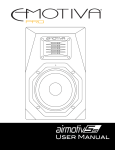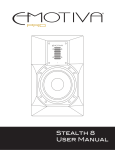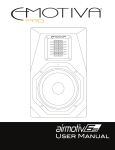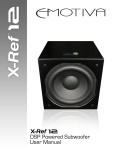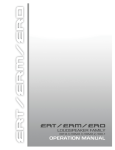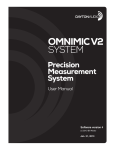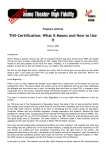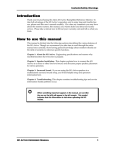Download Emotiva Airmotiv 4 Specifications
Transcript
Powered Bi-Amplified Monitors Contents Introduction.................................................................. 3 About This Manual......................................................... 4 Features....................................................................... 5 Unpacking.................................................................... 6 The Emotiva Powered Monitor.......................... 7 Quick Start................................................................... 8 About Near-Field Monitors.............................................. 9 Speaker Placement...................................................... 10 Connections................................................................ 17 Operation................................................................... 20 Adjustments............................................................... 21 Care and Maintenance.................................................. 22 Specifications.............................................................. 23 Troubleshooting........................................................... 24 Warranty.................................................................... 27 Contact Information..................................................... 27 Accessories................................................................. 28 Safety Instructions...................................................... 29 Notes......................................................................... 30 Page 1 Emotiva Pro and Airmotiv are registered trademarks of Emotiva Professional Systems, LLC. Emotiva and the “E” are registered trademarks of Emotiva Audio Corporation. Page 2 Introduction Thank you for purchasing your new Emotiva Pro monitors. bi-amplified powered studio The powerful internal monolithic amplifiers, coupled with our advanced input processing circuitry, deliver exceptional performance and stunning sound quality from a very compact system. The airmotiv high-frequency transducer produces crystal clear highs with vanishingly low distortion, excellent detail, and impressive dynamics. The 4.5 inch airmotiv low-frequency transducer delivers a fast, natural, extended low end with a beautifully integrated and cohesive midrange. The airmotiv is flat within +/- 3 dB from 52 Hz to 27 kHz; amazing performance for a speaker that occupies less than 1/3 of a cubic foot of volume. The exceptional performance of the airmotiv monitors ensure that they will work seamlessly in a wide variety of critical monitoring applications. Happy listening! The Emotiva Professional Team Page 3 About This Manual This manual will provide you with all the information you need to get great performance, accurate sound, and many years of reliable service from your Emotiva airmotiv powered studio monitors. Many of you are experienced studio professionals and are very familiar with powered near-field monitors. Since the airmotiv is intended for several different applications, you may find that some of the sections of the manual don’t apply to you. We suggest that you read through the entire manual as we kept things as short and direct as possible. Even if you’re an expert user, you might find some interesting information and useful suggestions. If you’re really in a hurry to get started, please read the Quick Start section (on page 8) and glance at the Safety Instructions (on page 29); you may then read the remainder of the manual at your leisure. You may wish to record serial numbers or other purchase information on the Notes page at the back of this manual. Page 4 Features Each Emotiva airmotiv4 is a fully self-contained bi-amplified powered studio monitor. The airmotiv is a two-way design that features quality construction and engineering throughout and incorporates discrete power amplifiers, precision active crossovers, effective yet unobtrusive overload protection, and a wide array of professional features. Some of the more important features of the Emotiva airmotiv include: • Accuracy and consistency. The gain and frequency balance of each airmotiv is factory calibrated to be within 1 dB of our reference standard. • Emotiva’s exclusive airmotiv high-frequency transducer, which delivers flat frequency response, low distortion, virtually nonexistent signal compression, smooth off-axis response, superb transparency, and uncanny imaging. • Emotiva’s airmotiv low-frequency transducer which, with its advanced Curv® cone material and synthetic butyl rubber surround, delivers clean accurate bass and is immune to moisture. • Perfectly balanced sound. Together, both transducers deliver balanced full-range sound at moderate listening levels. • An advanced cabinet made from 18 mm MDF, with computer optimized bracing, and a 3 mm layer of acoustic panel damping material to suppress vibration. • A tough exterior. The front baffle sports our attractive black lacquer finish, while the sides and back are covered with a durable heavy-duty textured vinyl laminate that resists scuffs, water, and fingerprints. • Plenty of clean power. The airmotiv is fully bi-amplified. The high-frequency transducer is powered by a 25 watt RMS amplifier, while the low-frequency transducer sports its own 25 watt RMS amplifier; both of which are fed by a precision multi-pole active crossover. • Effective yet unobtrusive protection, which individually protects each amplifier and transducer and prevents dangerous overdrive conditions, but doesn’t limit normal music peaks, or produce artifacts under normal listening conditions. • Maximum application flexibility, with both unbalanced (RCA) and balanced (XLR) inputs, and both high frequency and low frequency equalization adjustments. • High quality construction throughout, including all double-sided FR4 circuit boards, all precision resistors and precision film capacitors in the signal path, extensive use of surface mount technology, and an efficient low noise toroidal power transformer. • Full magnetic shielding. The airmotiv low-frequency transducer features full-coverage traditional magnetic shielding while the airmotiv high-frequency transducer is inherently shielded by its advanced design. You can find a more detailed list of features and more information about Emotiva’s exclusive airmotiv technology on our Web site at http://www.emotivapro.com Page 5 Unpacking Your Emotiva airmotiv powered studio monitors were carefully packed and should reach you in perfect condition. If you notice any shipping damage or other issues when you unpack them, please contact Emotiva immediately. Gently remove your airmotiv powered studio monitors from the packing carton and remove all wrappings and shipping material. Avoid pressing directly on the front of the low-frequency transducer or dropping any bits of packing material into the high-frequency transducer or rear port opening. It is important to save the box and all packing materials in case your airmotiv monitors ever need to be moved or shipped back to the factory for service. Please keep your sales receipt in a safe place. It is the easiest way to verify your purchase date for warranty purposes, and may also be required if you ever have to file an insurance claim. We truly value customer feedback and would like to hear from you. Page 6 The Emotiva Powered Monitor Emotiva’s exclusive airmotiv high-frequency transducer Emotiva’s exclusive airmotiv low-frequency transducer Level control and Power/Status indicator Linear taper tuned port High-frequency Equalization adjustment Balanced input (XLR) Low-frequency Equalization adjustment Unbalanced input (RCA) AC Power switch IEC power cable receptacle with integral fuse holder Page 7 Quick Start To get the most from your Emotiva airmotiv powered studio monitors, we strongly urge you to read the entire manual. If you just can’t wait to hear how great your airmotiv powered studio monitors sound, this section will cover the basics you need to get started. • Find a secure location for your airmotiv powered studio monitors. • Verify that the airmotiv monitors you received use the correct operating voltage for your location (the AC line voltage is marked on the rear panel of each monitor). • Verify that the front panel Level control on each airmotiv is in the calibrated (fully clockwise) position. • Plug your airmotiv powered studio monitors into grounded AC electrical outlets. If you use a different power cord or extension cord, use only a three-prong grounded type. • Connect a signal source to either the unbalanced (RCA) or balanced (XLR) input on the rear panel of each airmotiv monitor. (We recommend using a signal source with a variable output level, as this is much more convenient than having to adjust the level on the speaker itself.) • Turn on the Power switch on the rear panel of each airmotiv. • Enjoy the music. While you’re enjoying your airmotiv monitors, it would be a great time to read the rest of the manual to learn more about them. Page 8 About Near-Field Monitors In the past most recording studios used huge monitor loudspeakers, elaborate acoustic treatments, and large power amplifiers, in a large control room. Although a control room like that sounded great (usually), and made a big impression on customers, it also required large investments of space, time, and money. Ironically, many recording engineers preferred to be able to listen to their mix on a system that sounded more or less like what it would eventually be played on by the customer. A control room that sounded more like a concert hall than a living room didn’t work very well for them. Also, even though many of those impressive studio control rooms had a very nice sound, it was a very distinctive sound, so a mix might sound different when played in a different studio (or even a different room at the same studio). This made it difficult for the engineer to judge what a mix would actually sound like - which is, after all, the whole point of monitoring. All of this led to the current revolution in near-field monitors. A near-field monitor is simply a small accurate monitor loudspeaker that is positioned close to the console so that it is “playing directly to the engineer”. This location helps to reduce contributions from control room acoustics, especially those due to room reflections. In addition, the human brain tends to focus its attention on the sounds that arrive earliest, so the reflected sound that does arrive later has minimal influence on the overall sound. The result is a more accurate, and more repeatable, presentation of the music. By eliminating most of the control room’s contribution to the sound, nearfield monitors allow the recording engineer to hear what the music really sounds like. Many large studios, while they still have their big control rooms that allow large groups to listen at levels approaching a live performance, do a lot of their serious work on near-field monitors, and many recording engineers prefer them.The fact that near-field monitors work very well in small rooms with minimal acoustic treatment, and so reduce cost and space requirements, is also a major benefit for smaller studios and serious home recordists. The most significant requirement for near-field monitors is sound quality. Unlike a big speaker intended to play loud in a huge room, a near-field monitor must sound perfect at moderate listening levels, when located very close to the listener. It must deliver every nuance and detail of the music with perfect clarity, near-perfect accuracy, and extremely low residual noise. Because it may be located only a few feet from the recording engineer’s ears, it can’t make a lot of hiss, and the cabinet and drivers can’t contribute significant noise or distortion to the sound. In short, because the near-field monitor is almost a direct pipeline between the music and the engineer’s ears, it must do a superb job of delivering the music with virtually no coloration or distortion. Emotiva’s airmotiv monitors are your direct link to the music. Page 9 Speaker Placement Speaker placement is often a compromise between optimum performance, personal preference, and site requirements. The following guidelines will serve as a starting point to help you decide where to place your airmotiv powered studio monitors to achieve the best possible performance. Positioning your near-field monitors monitors as The Emotiva airmotiv was designed primarily as a superlative near-field monitor. When choosing optimum locations for near-field monitors, the goal is to locate them close to the recording console, and far from any walls or other reflective surfaces, to maximize direct sound while minimizing reflected sound. • Mount your airmotiv powered studio monitors on separate stands, or mounts, if possible. If you place them directly on the meter bridge or the same table as your console, vibrations may be coupled to the console. You should consider using a decoupling platform beneath each monitor. Mounting points for brackets are provided on the bottom surface of each monitor. • Locate your monitors close to the recording console, and away from walls or other large reflective surfaces. If there are large reflective surfaces nearby, covering them with commercial sound absorbing materials (or felt, or a tapestry) may improve frequency response and imaging. Listener Typical near-field monitor placement Page 10 • If possible, mount your airmotiv monitors upright (with the high-frequency transducer on top), vertically (not angled upwards or downwards), with the middle of the front baffle at approximately the same height as the engineer’s seated head height, and toe in each speaker so the front is directly facing towards the engineer’s head. • Locate your airmotiv monitors so that the distance between them is approximately the same as the distance between each monitor and the engineer’s head (the monitors and the engineer should form an equilateral triangle). • If your monitors must be mounted above head height, tilting them down to directly face the engineer’s seated head position is suggested, and mounting them upside down (high-frequency transducer towards the floor) will produce better results in many cases. The goal is to maximize direct sound reaching the engineer and minimize reflected sound. If possible, avoid mounting your monitors in the upper or lower corners of the room (doing so will enhance bass output, but will often produce muddy bass and adversely affect imaging.) • If conditions require that your monitors be placed on a table or other horizontal surface, or with other large reflective surfaces between them and the console, you can minimize reflections by covering the surface with sound absorbing material. • Always leave several inches of clearance behind your airmotiv powered studio monitors to avoid blocking the rear-positioned port and to allow the amplifiers to dissipate heat via the aluminum back plate fins, which will get warm in normal operation. Page 11 Positioning your monitors as stereo speakers The Emotiva airmotiv work beautifully as a full-range speakers in a small audiophile two-channel system, and as a satellite speaker in a larger two-channel system with the addition of a sub-woofer. When choosing optimum locations for speakers in an audiophile home stereo system, the goal is usually to optimize the frequency response and imaging. • Mount your airmotiv speakers on separate stands, or using brackets if possible. Locating your speakers away from the front wall will usually result in better imaging and frequency response. Placing them directly on a (sturdy) wall-mounted shelf may also produce satisfactory results. If possible, mount your airmotiv speakers upright (with the high-frequency transducer on top), vertically (not angled upwards or downwards), with the middle of the front baffle at approximately the same height as the listener’s seated head height, and toe in each speaker so the front is directly facing towards the listener’s head. • Locate your airmotiv speakers so that the distance between them is approximately the same as the distance between each speaker and the listener’s head (the speakers and the listener should form an equilateral triangle). • In larger rooms, or if you wish to optimize speaker performance for several listeners or a wide listening area, mounting the speakers with no toe-in will result in a wider sweet spot with a slightly wider soundstage. • Avoid locating your airmotiv speakers close to side walls if possible. If you have Listener Typical stereo speaker placement Page 12 Listener Typical placement of stereo speakers to cover a wide listening area • • • • large reflective or sound-absorbing surfaces on the side walls, try to make them as symmetrical as possible. (If there is a large glass window on one side wall, balance it by hanging a large glass picture on the other, or by covering it with a material which more closely matches the acoustic properties of the opposite wall. If there is a large couch on one side of the room, try balancing it with a tapestry on the other side.) If you prefer to mount your airmotiv speakers above head height, tilting them down to directly face the listener’s seated position is suggested, and mounting them upside down (high-frequency transducer towards the floor) will produce better results in many cases. The goal is to maximize direct sound reaching the listener. If possible, avoid mounting your speakers in the upper or lower corners of the room (doing so will enhance bass output, but will often produce muddy bass and adversely affect imaging.) If you place your speakers on a table, wide shelf, or other horizontal surface, covering the surface in front of the speakers with a felt pad or other similar material will reduce reflections and improve the sound. Always leave several inches of clearance behind your airmotiv powered studio monitors to avoid blocking the rear-positioned port and to allow the amplifiers to dissipate heat via the aluminum back plate fins, which will get warm in normal operation. If your system includes a sub-woofer, position and configure it according to the manufacturer’s instructions. Page 13 Positioning your monitors as satellite speakers in a multi-channel mastering or surround sound system Emotiva’s airmotiv powered studio monitors work great as satellite speakers in a high-quality multi-channel playback or mastering system. When choosing optimum locations for speakers in a multi-channel system, the goal is to optimize the frequency response and imaging. However, because more speakers are required, you are more likely to encounter practical constraints on where they can be located. Various surround-sound systems and standards also recommend slightly different speaker placement for optimum performance. When listening to most music, the surround speakers are primarily used for ambience information. In most movies, important and highly localized information is present in the front and side channels. It is therefore more critical that those speakers be placed in their optimum locations. A typical surround sound system may also use a mix of different models and types of satellite speakers (possibly including bipole or dipole speakers for surrounds). For example, a superb system could be built by using Emotiva’s airmotiv6 powered studio monitors for front speakers and airmotiv4 (or airmotiv5) powered studio monitors for surrounds. Since all airmotiv monitors share the same basic technology, and are voiced similarly, they will work exceptionally well together in any combination in a surround or multi-channel playback system. Some systems may also use a mix of airmotiv powered studio monitors and traditional speakers and amplifiers. For example, if you already own passive monitors and a stereo power amplifier, you could upgrade to surround-sound by adding a pre-processor and three airmotiv powered studio monitors (one front center and two surrounds). This way you would avoid the need for more amplifier channels and minimize the number of additional connections. Sound is subjective, and both room acoustics and personal preference play a big part in the listening experience, so use these guidelines as a starting point, but feel free to experiment until you achieve the sound you like best. • If possible, for best imaging and soundstage, mount all of your airmotiv speakers upright (with the high-frequency transducer on top), vertically (not angled upwards or downwards), with the middle of the front baffle at approximately the same height as the listener’s seated head height. • Place your left-front and right-front speakers flanking the video display (TV). The distance between left-front and right-front speakers is a matter of preference; placing them close to the display will tend to focus attention on the picture (especially with smaller displays), while moving them further apart will tend to widen the soundstage. Whether to apply toe-in or not is also a matter of preference. Page 14 Sub-woofer Display Center Left Front Right Front Right Side Surround Left Side Surround Listener Listener Left Rear Surround Right Rear Surround One example of placement for surround-sound speakers • Place your front-center speaker either directly above or directly below the display. If you have a large display and the front-center speaker must be placed above head height, better results may be achieved if it is mounted upside down (high-frequency transducer towards the floor) and slanted slightly downwards toward the listener. Next in order of preference would be to place the center speaker on its side in either location. If both of these locations are impractical, and especially if the left-front and right-front speakers are located far from the display, the front-center speaker can be located directly to one side of the display (this location isn’t optimal, but may work reasonably well in some situations). • If your location permits it, the ideal arrangement is to place your left-front and right-front speakers on stands away from both the front and side walls. They should be placed such that the left-front, center-front, and right-front speakers form an arc equally distant from the central listening position. • Side surrounds are typically mounted above head height and approximately even with the center of the listening position. • Rear surrounds are located, as you might guess, at the rear of the listening position, and are typically mounted on brackets on the rear wall above the listening position. Page 15 • Because surround speakers carry mostly ambience information and are influenced by the listening room, and because they are also used differently by different surround-sound decoding standards, you should experiment to find the best locations and orientations for your particular installation. We suggest you try them at various angles, and in various orientations (vertical, upside down, and even sideways) to identify the location and orientation that work best with your room. Some installations locate the surrounds facing sideways along the side or rear wall. The best way is whatever works well for you in your room. Surrounds should always, however, be positioned symmetrically (so, for example, if you locate your left side surround on its side with the high-frequency transducer towards the rear of the room, you should also locate it’s counterpart, your right-side surround, on its side with the high-frequency transducer towards the rear of the room. • While you should avoid mounting front speakers in the corner angles of a room, corners are acceptable locations for surround speakers, but you may need to adjust the Low-frequency Equalization for best results. • Always leave several inches clearance behind your airmotiv powered studio monitors to avoid blocking the rear-positioned port and to allow the amplifiers to dissipate heat via the aluminum back plate fins, which will get warm in normal operation. Positioning your speakers monitors as computer The Emotiva airmotiv also makes an incredible computer speaker. When choosing optimum locations for computer speakers, most people prefer to position them as they would near-field monitors. If your computer also provides music for your entire living room or office, you may wish instead to position your airmotiv powered studio monitors as you would for a small high-end home stereo system. Positioning your monitors for use with a music client or portable music player The Emotiva airmotiv will deliver beautiful high-quality sound when connected to a music client or portable music player. Depending on your specific requirements you may choose to position them as you would near-field monitors or as you would normal stereo speakers. Please refer to the appropriate section for more details. Page 16 Connections Note: The level controls on the airmotiv are intended to be left in the calibrated (fully clockwise) position in normal use. Level should be controlled by your source equipment; therefore your airmotiv monitors should always be connected to variable outputs rather than fixed outputs. Connecting your monitors to a studio console Virtually all studio equipment offers balanced outputs, which are the preferred method of connecting your airmotiv powered studio monitors. Connect your airmotiv monitors to a variable-level output on your console - or whatever equipment you plan to use them with. Connecting your monitors to a home stereo or surround sound system Connect your airmotiv speakers to the same type of variable line-level output to which you would normally connect a power amplifier, such as the output of a console, preamp, or surround-sound processor. DO NOT connect your airmotiv monitors to the speaker outputs of an amplifier or receiver or damage to your airmotiv speakers and your equipment may result. Balanced (XLR) outputs offer several benefits, and are the preferred method for connecting your airmotiv monitors; connect a high quality balanced cable between each airmotiv and your signal source. If your source equipment offers only unbalanced (RCA) outputs; connect a high quality unbalanced cable between each airmotiv and your signal source. (If your source equipment offers only unbalanced outputs, there is no sonic benefit to using converters to connect them to the balanced inputs on the airmotiv speakers unless you are experiencing hum or line noise problems.) When used as satellites or surrounds in a home-theater or stereo system with a sub-woofer, your airmotiv speakers should be set as “small” speakers in your surround-processor or preamp’s configuration. Connecting your monitors to a music client Connect your airmotiv speakers to the same type of variable line-level output to which you would normally connect a power amplifier. Some music clients offer both variable and fixed outputs, and some require that you enable variable control of the output from a menu setting. Note: DO NOT connect your airmotiv monitors to any digital outputs on your music client or damage to your airmotiv speakers and your music client may result. Page 17 Connecting your monitors to a portable player Most portable music players offer only unbalanced outputs, usually via a 1/8” jack. Connect your airmotiv speakers to a variable output (which is often also the headphone output). Use a high quality, well shielded adapter cable to connect the output to the unbalanced (RCA) inputs of your airmotiv speakers. A single “long Y-cable” is preferable to multiple separate adapters and extension cables. If you have an iPod® dock or other similar device, connect your airmotiv speakers to the same output you would connect to the input of an amplifier or receiver; if the line output on the dock doesn’t offer level control, then connect the cable to the headphone output of the device. Connecting your monitors to a computer Connect your airmotiv speakers to the same line-level output intended for powered computer speakers. Depending on your computer or sound card, this may be labeled as “line out” or “speaker out”. Make sure to choose outputs whose volume is controlled by your computer’s operating system. Try to avoid outputs intended to drive small unpowered speakers directly as these often have unacceptable sound quality. If no other options are available, headphone outputs should be OK. Most computers offer only unbalanced outputs, usually via one or more 1/8” jacks. Use a high quality, well shielded adapter to connect the output to the unbalanced (RCA) inputs of your airmotiv speakers. A single “long Y-cable” is preferable to multiple separate adapters and extension cables. Balanced and unbalanced connections The airmotiv powered monitor offers both unbalanced (RCA) and balanced (XLR) input connections. The main reason balanced connections are favored on professional equipment is that they are very resistant to outside noise and interference, especially with low-level signal sources (like microphones), and in difficult situations (a need to run signal cables near power cables or in otherwise noisy environments). Balanced connections also offer a slight improvement in the S/N ratio of the signal itself under certain conditions (but only if the equipment at both ends is designed to do so). In general, using a balanced connection and cables is the best option if the equipment at both ends offers it. If that option isn’t available, however, good quality unbalanced cables usually work quite satisfactorily. To correct a common misunderstanding, if no hum or noise is audible with an unbalanced connection, there is no specific technical reason to expect a balanced connection to sound better. (However, in a given piece of equipment, one or the other output may sound audibly better because of how the output circuitry was designed. In that case, however, it isn’t necessarily the balanced output that will be superior.) Page 18 Avoiding Hum and Noise The following guidelines should help you avoid or eliminate hum and noise. These aren’t rules, and may not apply in all situations, but the more closely you follow the guidelines, the more likely you are to avoid hum and noise problems. Hum and noise are most often caused by ground issues such as ground loops, non-optimal cabling or cable placement, or faulty equipment. Hum may also arise due to how equipment is arranged and connected. If, after following these guidelines, you still have hum or noise problems, please call Emotiva Technical Support. Equipment • Make sure that all equipment and outlets are properly grounded. • Some equipment (especially turntables and phono and microphone preamps) have special grounding requirements. • Some audio equipment (especially vacuum tube equipment) has a high output impedance, which may render it especially sensitive to hum and noise pickup. If so, it is essential that signal cables be kept short, of good quality, and not run near power cables. • With some older equipment that lacks a grounded power connector, you may experience more or less hum depending on which way the plug is inserted. Cables • Always use high quality, fully shielded cables. • Balanced connections and cables are more resistant to hum and noise than unbalanced cables. • Always ensure that all cables are plugged fully in, that the connectors fit firmly, and that the cables and connectors are in good condition, with no bent pins or corrosion. • Verify that the cables themselves are wired properly according to standards. (You may encounter custom or modified cables, especially in studios.) Cable Topology (runs) • Always run cables as directly as possible, and use the shortest cables that fit your requirements. Avoid using excessively long cables and coiling up the excess, especially with unbalanced connections. • If long cable runs are required, then using a balanced connection is more important, and is strongly suggested. • Avoid running signal cables next to power cables. If this is unavoidable, then using balanced cables is virtually a necessity to avoid hum problems. • If you cannot avoid using unbalanced cables in close proximity to power cables, try not to run them parallel to each other, and try to ensure that, if and when they cross each other, they do so at right angles. Page 19 Operation Once you have decided upon a location for your airmotiv powered studio monitors and connected them, operation is very simple. • Plug your airmotiv powered studio monitors into a grounded electrical outlet of appropriate voltage. (Verify that your airmotiv powered studio monitors are the correct models for your local AC line voltage. The correct line voltage is shown on the rear panel.) • Connect a signal source to either the unbalanced (RCA) or balanced (XLR) input on the rear panel of each airmotiv. • Place the Power switch on the rear panel of each airmotiv in the ON position. • Immerse yourself in the music! Level Control With a powered monitor, listening level is usually controlled by the source equipment. While the airmotiv includes a front-panel Level control, which may be used to adjust for unusual signal levels from specific signal sources, this control is usually left in the calibrated (fully clockwise) position. A simple press will cause the control knob to pop out for easy access, and another press will return it to the recessed position to help avoid unintentional level changes. You can turn the Level control with your fingertips when it is in the recessed position Power and Status Indicator The ring around the front panel Level control serves as a Power and Status indicator. In normal operation, a cool blue glow indicates that your airmotiv is powered on and operating normally. The ring will flash red to indicate that the automatic protection circuitry is being engaged to protect the airmotiv from a dangerous overload condition. (If the ring remains red for extended periods of time, then you are probably over-driving your airmotiv monitors and should reduce the volume.) Page 20 Adjustments The airmotiv powered monitor is calibrated at the factory to ensure that its low-frequency gain, high-frequency gain, and overall gain are within 1 dB of our reference standard. Equalization controls are provided to compensate for various room acoustics and speaker placement issues. In most situations it is strongly recommended that equalization adjustments be applied equally to symmetrical pairs of airmotiv monitors. Failure to do so will adversely affect imaging and soundstage. Low-frequency Equalization The Low-frequency Equalization control is intended mainly to compensate for the “boundary effect” that increases bass output when a speaker is placed near one or more surfaces or corners. On the airmotiv, this control affects mainly frequencies below 150 Hz and offers a maximum reduction of -2 dB or -4 dB at 20 Hz If you notice excessive or “muddy” bass, especially if your airmotiv monitors are placed near large surfaces or room corners, try setting the Low-frequency Equalization to -2 dB or -4 dB. High-frequency equalization The High-frequency Equalization control is intended to compensate for room acoustics (“bright” or “dull” rooms). On the airmotiv, this control affects mainly frequencies above 4 kHz and offers a gain or reduction in high-frequency output of +2 dB or -2 dB at 4 kHz If you notice excessive brightness or harshness, especially if your room contains a lot of reflective surfaces, try setting this control to the -2 dB position. If your room contains lots of sound absorbing surfaces, and your music sounds dull, try setting this control to the +2 dB position. Setting this control to -2 dB may also improve the overall sound when playing highly compressed music from a portable music system (MP3 files and files heavily compressed using other lossy formats tend to have artifacts and distortion which are most noticeable at higher frequencies). Page 21 Care and Maintenance Periodic Maintenance Your Emotiva airmotiv powered studio monitors are factory calibrated and require no periodic maintenance or calibration. Cleaning the Cabinet and Baffle • The cabinet of the airmotiv powered monitor should normally be cleaned with a rag dampened with plain water. DO NOT spray water directly onto or into the monitor, transducers or connectors, and DO NOT use abrasive or chemical cleaners. Gently dry the surface with a clean soft rag after cleaning. • If necessary, use a mild detergent, wipe the surface with a rag dampened with plain water afterwards to rinse it, and then gently dry the surface with a clean soft rag. • If something nasty does get on the sides or top of your airmotiv, use a rag dampened with a weak solution of dish detergent or other mild cleaning liquid, followed by a rag dampened with plain water, and then dry with a clean rag. Avoid applying cleaning liquid to the front baffle. Cleaning the Low-frequency Transducer • Is something gets spattered on the cone or surround of the low-frequency transducer, it may be carefully cleaned with a dampened rag. Be careful to avoid excessive pressure. Cleaning the High-frequency Transducer • If dust or fuzz finds its way into the front of the high-frequency transducer, you can try to dislodge it by blowing gently into the front of the transducer at an angle. • DO NOT reach into the front of the transducer with foreign objects (like tweezers) to remove lint or dust as you may easily damage the transducer. • DO NOT use high pressure air for cleaning! This may damage the membrane. • If foreign objects or dirt become lodged in the transducer, contact Emotiva Technical Support for assistance. Changing a Fuse • If the fuse blows, ALWAYS REPLACE IT WITH ONE OF THE SAME SIZE, RATING, AND TYPE; NEVER USE A FUSE OF HIGHER RATING. • If the fuse blows repeatedly CONTACT EMOTIVA TECHNICAL SUPPORT. (If there is any doubt, first verify that your AC power source is the correct voltage.) • To change the fuse, use a screwdriver to release the fuse holder. The fuse holder is the little plate with the picture of a fuse on it (which is part of the IEC power cord receptacle). First remove the power cord. Then pry up on the edge of the plate nearest the power cord opening, and the fuse holder will slide out like a drawer. Replace the fuse with one of the same size, rating, and type and carefully replace the fuse holder (be sure to press firmly so it locks into place). Page 22 Specifications Frequency Response: 52 Hz to 27 kHz +/- 3 dB Input Connectors: One unbalanced (RCA) One professional balanced (XLR) Driver complement: One 26 x 32 mm airmotiv high-frequency transducer One 115 mm (4.5 inch) airmotiv low-frequency transducer Bass Alignment: Single rear-oriented port with linear taper Amplification: High-frequency amplifier: 25 watts RMS; S/N > 90 dB; THD+N < 0.05% @ 15W, 10 kHz Low-frequency amplifier: 25 watts RMS; S/N > 90 dB; THD+N < 0.05% @ 20W, 100 Hz Crossover: Precision multi-pole phase compensated fully active crossover Crossover frequency: 2700 Hz Adjustments and Calibrations: HF gain, LF gain, and overall gain calibrated to standard within 1.0 dB High frequency adjustment: 4 kHz turnover frequency; 0 (calibrated), +2 dB, -2 dB @ 20 kHz Low frequency adjustment: 150 Hz turnover frequency; 0 (calibrated), -2 dB, -4 dB @ 20 Hz Power Source: 120 VAC 50/60 Hz +/- 10% or 230 VAC 50/60 Hz +/- 10% IEC standard removable power cord Size and Weight: Size (each): 9.4” high x 6.1” wide x 7.3” deep (240 mm x 155 mm x 186 mm) Size (pair; packaged): 16.7” long x 10.5” wide x 13” high (423 mm x 268 mm x 330 mm) Weight (pair; packaged): 24.25 pounds (11 kg) Weight (pair; net): 20.5 pounds (9.3 kg) Mounting: Bottom mounting points for use with our (optional) mounting brackets. Page 23 Troubleshooting Emotiva’s airmotiv powered studio monitors are carefully designed and manufactured from high-quality precision components to ensure years of trouble free operation. The troubleshooting section describes some common problems and how to eliminate them. If this doesn’t solve your problem, please contact Emotiva Technical Support, where a real person will be glad to help you get up and running. Please remember to power down your airmotiv monitors and all connected equipment before changing or disconnecting cables. The following three procedures will address the vast majority of problems that you may encounter: Set the front panel Level control: The airmotiv is typically used with the front panel Level control in the fully clockwise (calibrated) position. A quick press will pop the knob out for easy access, and another quick press will return it to the recessed position after you adjust it (to discourage inadvertent changes). Check the power connections: The blue power indicator on the front of the airmotiv (the ring around the Level control) should remain illuminated when the unit is on (it changes to red when the protection is engaged). If you don’t have power, verify that the rear panel power switch is on, that the removable power cord is fully inserted into its back panel receptacle, that you’re plugged into an active AC outlet of correct voltage, and that the fuse (in the power receptacle) is not blown. Check the signal source: It’s a good idea to verify that your signal source is working, that all cabling is correct and intact, and that signal is present on the input of your airmotiv monitors. First, check the source itself by trying different media (like a different CD), or a different source component. Next, make sure that your source is properly configured, that its output level is set correctly, and that your interconnect cables are properly connected and in good condition. If the problem is common to both channels, verify that all switches are in their proper positions, and that the output you are using is enabled. If the problem is occurring in only one channel, test each channel by disconnecting each cable at the monitor and swapping them. By swapping the left and right connections at different points, you can easily narrow the problem down to a particular cable or piece of equipment. Page 24 Problem: No output at all • • • • Verify that you have power. Check your signal source. Verify that your front panel Level control is not set to its minimum setting. If the front panel power indicator is lit red, but the airmotiv is playing quietly or is silent, then there is a fault with either your signal source or the monitor. Problem: Excessive hum or noise • Read the chapter titled Avoiding Hum and Noise in the Connections section of this manual. • Check your signal source. • Verify that all cables are plugged fully in, that the connectors fit tightly, and that the cables and connectors are in good condition. • Try repositioning cables. If you have signal cables running near power cables, try moving them further apart. (This is especially important with unbalanced cables.) • If you are using unbalanced connections, try higher-quality cables with better shielding. If that reduced but fails to eliminate the hum, consider trying balanced cabling (especially for long runs or where runs next to power cables are unavoidable). • If you’re already using a balanced connection, the balanced outputs on some equipment may offer various options including “ground lift”. While none of these options is specifically recommended, some may produce good results in some situations. • Some audio equipment (especially vacuum tube type) has a high output impedance, which makes it inherently sensitive to picking up hum and noise, especially if only unbalanced connections are provided. It is essential that signal cables used with such equipment be kept short, of good quality, and not run near power cables. • In a new installation, especially in a studio environment, verify that your cables are wired properly. (In studios, pros often customize cables for various reasons, which may include removing ground connections from one or both ends.) If you suspect that your cables are non-standard, either check them with an ohmmeter or try another cable. • Some difficult installations may require a balanced connection to completely eliminate hum and noise. Problem: Intermittent sound • If the power indicator is flashing red, this indicates that the protection circuitry is engaging frequently, which may result in intermittent or distorted sound. • If the protection circuitry is engaging, yet the sound level is not excessive, then excessive low-frequency signal (possibly from a warped record on a turntable), or excessive high-frequency signal (possibly from high-frequency feedback or a defective signal source) could be triggering the protection circuitry. Page 25 Problem: Low but undistorted sound • Verify that the Level controls on both (or all) monitors are in their calibrated positions. • Check your signal source. Problem: Unbalanced sound or poor imaging • Verify that the Level controls on both (or all) monitors are in their calibrated positions. • Verify that the rear panel equalization controls, which are used to compensate for speaker position and room acoustics, are set in the same position for each monitor. In general, although some situations may demand unusual settings, the best performance will be achieved if the equalization controls on symmetrical pairs of monitors, such as a single pair of monitors or a pair of surrounds, are set the same. If not, uneven frequency response and poor imaging may result. Problem: No sound from only one transducer • If the power indicator is flashing red frequently, this indicates that the protection circuitry is engaging frequently, which may result in intermittent or distorted sound. If you are playing the monitor at excessively loud levels, then you should reduce the volume level. • Check your signal source. • Try swapping monitors. If the problem is definitely associated with one unit, then contact Emotiva Technical Support. Page 26 Warranty All Emotiva products feature a FIVE-YEAR FULLY TRANSFERABLE WARRANTY. Contact Information Emotiva Professional Phone Numbers 615-791-6254 | 855-EMO-PRO1 (855-366-7761) Monday through Friday 8am - 5pm (Central Standard Time) Emotiva email addresses Online sales, product information, and general questions: [email protected] Customer service related inquires: [email protected] Technical support or service issues: [email protected] Emotiva Professional Web site www.emotivapro.com Emotiva Shipping Address Emotiva Professional Systems, LLC 131 Southeast Parkway Court Franklin, TN 37064 Note: To return items purchased through Emotiva Professional for repair, warranty work, or refund you MUST call us at 1-855-EMO-PRO1 to obtain a Returned Merchandise Authorization (RMA) number. Our Shipping Department will NOT accept packages unless they have a valid RMA number clearly indicated on the outside of the package. ALL returns must be in original packing materials (we’ll send you new ones if you’ve lost or discarded yours), and should be addressed to “attn: Customer Service RMA xxxx” at the address above. You will find more details about the return process on our Web site (www.emotivapro.com), and our Technical Support department will be glad to help you. Page 27 Accessories Interconnect cables Using high-quality interconnect cables will ensure that you get the best sound quality and maximum reliability from your airmotiv powered studio monitors. It is especially important to select good-quality well-shielded cables if you are using unbalanced cables, or very long cables, or have an especially noisy environment. (We do not, however, recommend or endorse fancy “boutique” audiophile cables.) Emotiva Audio offers both balanced and unbalanced cables that combine solid engineering, premium build quality, excellent performance, and reasonable cost. If you choose to use third-party cables, avoid those that have excessively thin and flexible insulation or that fail to provide full-coverage shielding. Cables with insufficient mechanical integrity may fail prematurely, and cables with poor shielding will be more subject to hum and noise. Mounting brackets Emotiva Professional offers optional brackets especially designed to mount your airmotiv monitors securely and conveniently. See our Web site for details. Page 28 Safety Instructions The following Safety Instructions will not only serve to protect your personal safety, but will also help to ensure a long and trouble-free service life for your airmotiv powered studio monitors. While you will find that most of the safety instructions involve simple common sense, you should remember that your airmotiv powered studio monitors are both loudspeakers and electronic equipment, and the safety instructions therefore include both mechanical and electrical considerations and concerns. • Always connect your airmotiv powered monitor to a properly grounded outlet which supplies the correct voltage, using either the supplied power cord or an equivalent replacement. The airmotiv powered monitor draws very little power, and you may safely use a longer replacement cord or extension cord if desired. (If so, always use a three-prong grounded type.) • Always mount or place your airmotiv powered monitor in a secure location, especially if it is to be placed above head level. If placed on a shelf, we suggest placing rubber shelf matting or rubber feet underneath to prevent slipping. If you use brackets, ensure that the brackets are tightly attached to both the speaker and a solid mounting surface, and that they are rated to support at least 15 pounds (each airmotiv weighs about 11 pounds). • Do not store or use your airmotiv powered monitor near water or in an overly damp location. (Remember that they are an AC-powered electrical appliance.) • Do not expose your airmotiv powered monitor to rain, lawn sprinklers, or excessively dusty conditions (they are not an outdoor speaker and are not waterproof). • Do not mount your airmotiv powered monitor near or directly over a heat source (avoid placing them in front of heaters or heating ducts or on top of hot equipment). • Do not mount or place your airmotiv powered monitor where it will be exposed to direct sunlight for extended periods of time. • Never place liquids (like cups of coffee or soda) on top of an airmotiv. • Never spray or pour liquids directly into or onto your airmotiv powered monitor. To clean the exterior, use a rag dampened with plain water, and apply the liquid to the cleaning rag and not the speaker. • Never press on the low-frequency transducer and never insert foreign objects into the high-frequency transducer. If dust or lint find their way into the high-frequency transducer, attempt to remove them by blowing gently into the front grill at an angle. • IF YOUR airmotiv POWERED MONITOR IS EXPOSED TO LIQUIDS OR RAIN, IS DROPPED OR PHYSICALLY DAMAGED, OR OTHERWISE FAILS TO OPERATE PROPERLY, contact Emotiva Technical Support immediately. Page 29 Notes Page 30


































